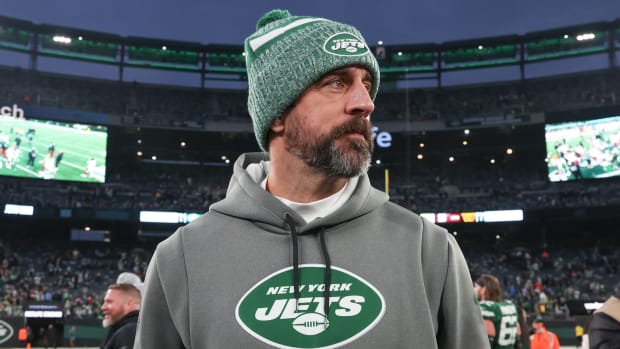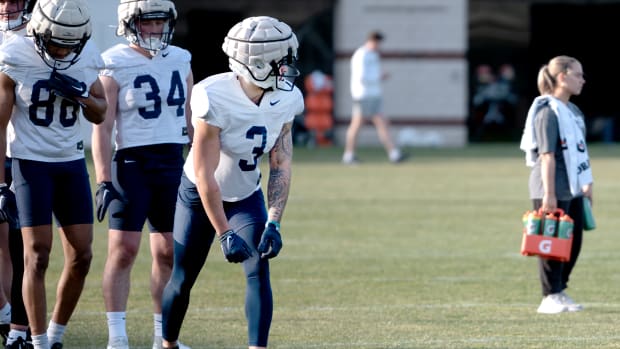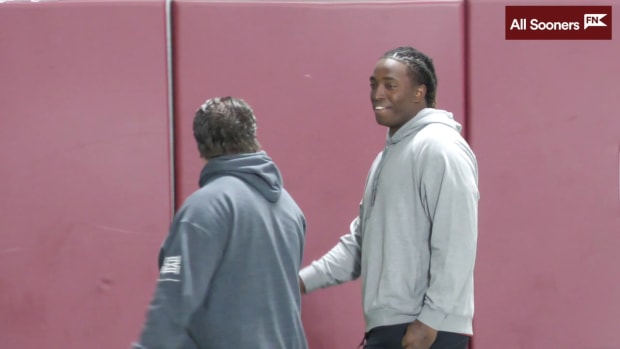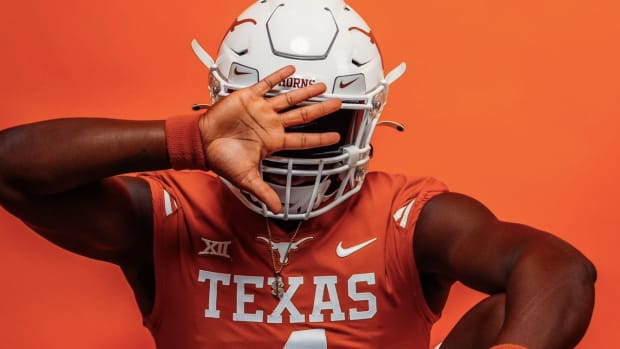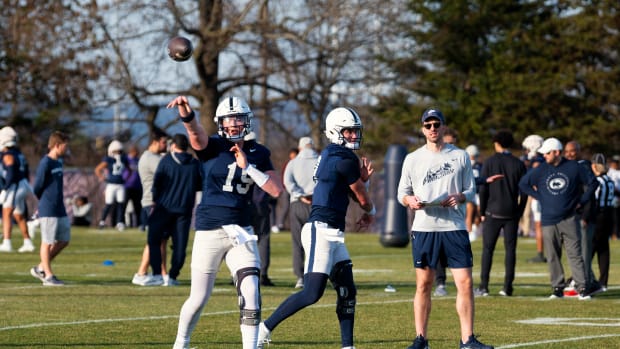LAKE CHARLES, La. — They call Cowboy Stadium “The Hole” because it plunges into the ground.
This place is sacred, an archaic cathedral to college football, protected on all four sides by mounds of earth guarding this community’s spiritual center—a green, artificial turf field marked with blue-and-yellow signage of the McNeese State Cowboys. And though it is not as gigantic as some others in this football country—its concrete bleachers hold about 17,600—the Hole’s significance to people here, dropped in the heart of Louisiana’s fifth-largest city, is dwarfed by only the neighborhood church.
“As far as I’m concerned,” says Paul Chafin, standing in his front yard and gesturing toward the stadium just a block away, “there’s no other place to be on a Saturday night.”
The Hole, very much like this community, is hurting, devastated by what experts say was the 10th-strongest hurricane to hit the continental U.S. in recorded history. The Hole’s guardians, those high hillsides, stood no chance against Hurricane Laura’s wind gusts of more than 150 miles per hour, torrential rains and twisting tornadoes.
Frank Wilson, in his first year as football coach here, has surveyed the destruction enough over the last month to quickly walk a visitor through the ways that Laura thrashed this place on Aug. 27.
A new Jumbotron, set to make its debut this season, is mangled. The goal posts are crooked. The press box, a hole ripped into its side and windows blown out, is completely uninhabitable. The turf, weeks later, is still partially submerged in rainwater.
And in one of the most remarkable pieces of evidence of Mother Nature’s fury, two of the stadium’s metal lighting spires were snapped halfway up. Like the top branches of a felled tree, the giant cluster of metal work and lighting bulbs are crumpled—one smashing to the ground and another crashing into the bleachers.
“We need help,” says Wilson. “It’s been a month, and we don’t have power on campus.”
While the world is busy quibbling over politics during an election year marked with social unrest and a global pandemic, Lake Charles and McNeese State are reeling. The people here feel forgotten, passed over by a furious news cycle in a year of the catastrophic bizarre.
While most of America attains some semblance of normalcy six months into the pandemic, southwest Louisiana is a wreck. Laura’s most intense portion, the northeastern eyewall, roared directly through Lake Charles, delivering a punch of historic winds to this place. For more than two hours, sustained winds were recorded at 137 miles an hour.
Imagine a giant tornado and then quadruple its size, says Daryl Burckel, the McNeese State president. This 40-square mile monster ripped apart Lake Charles, leaving behind hundreds of uprooted trees, heaps of twisted metal, crumbled brick walls, debris piles eight foot high, roofless residences and a population of blue-collar people who used chainsaws to quite literally cut their way back into their leaky homes.
Because they didn’t receive the projected storm surge, national weather forecasters and even some government officials believe this area escaped disaster. They dodged a bullet.
“We got hit by a different bullet,” says Justin Hill, McNeese State’s head baseball coach, while standing among a soggy, unidentifiable mess—the first base line of his ballpark.
College sports here have always served as a post-disaster rallying point. In the aftermaths of hurricanes Katrina and Rita, the immediate return of football provided hope to this place—as it does now for millions nationwide emerging from a pandemic.
Without college football, what do they rally behind here?
“Football in the spring,” says Louis Bonnette, a long-time McNeese State sports information director who is now retired and lives just paces from the school’s football stadium.
On Bonnette’s stovetop, a giant pot is producing Louisiana’s state fragrance: gumbo. “It’ll be done soon if you want some,” he offers. Bonnette is happy to have a home-cooked meal. He points to an opened cardboard box on his floor, its contents spilling out. The MREs—Meals Ready to Eat—are individually packaged and “aren’t too bad actually,” Bonnette smiles.
The Bonnettes recently had power restored after living more than three weeks without it. Several businesses and residences here, including athletic facilities on McNeese’s campus, are still powered by only generators, the massive gas-fueled engines whirring outside of their homes. Roughly one-third of Calcasieu Parish is still without electricity, says Burckel.
Cable access is inconsistent among neighborhoods. The internet, for those lucky enough, is available on only smartphones. For some, news outside of Lake Charles is hard to come by. Bonnette, 80, still has a flip phone. His transistor radio is unreliable, and the local newspaper, The American Press, has stopped printing because of damage to its building. A man who’s spent his life tracking news and writing it, Bonnette spends his days wondering what the hell is going on out there while reading, for a 15th time, a set of golf magazines previously delivered to the house.
Weeks ago, there were more pressing issues. Like no running water. Wilson, for instance, used water from his swimming pool for plumbing purposes, scooping it out of the pool with a pot, pouring it into his commode and, well, then, you know. “It was like a third-world country here,” he says.
In some respects, it still seems that way. At night, it is dark. Real dark. Eerily dark. Businesses were closing at 6 p.m. as part of a curfew that only this week moved to 10. There are no streetlights and few car headlights.
After evacuating to Baton Rouge, Wilson returned to Lake Charles a day after the storm to retrieve one of his football players—a “tough guy,” Wilson now says, laughing, who rode out the storm in an apartment in the middle of the city. The hurricane tore off a portion of the complex’s roof. Wilson arrived to find the player in a dark, hot apartment with no water or power and a leaking ceiling.
“He’s telling me, ‘Coach, I’m going to tough it out.’ I said, ‘No you’re not.’ ” The player is now back home with family in Florida.
Many residents evacuated. Some rode it out, now equipped with horror stories about the experience. Chafin, who works at McNeese and whose home is a block from the Hole, spent 1 a.m. to 4 a.m. buried beneath a mattress in an inner-hallway of his home, his wife, Becky; their pitbull; and three cats all curled together. Power went out, the house shook and for three hours the whirring never stopped from outside.
Chafin had moments of doubt that they’d survive. “We were getting a bit closer to God,” he says. “You’ve heard the comparison to a train or a locomotive. This was like three jet engines outside of your window.”

Paul Chafin lives about a block from McNeese's Cowboy Stadium, aka The Hole. He feared for his life as the storm, for more than two hours, roared around him. After Hurricane Laura passed, he and wife Becky walked outside to find the roof of their neighbor's carport in their yard. You can see it in this photo, over Chafin's right shoulder.
Ross Dellenger/Sports Illustrated
At some point, they heard a metallic crunching, learning later that it was only the neighbor’s carport roof having wedged itself between his home and an oak tree in his front yard.
Burckel, the McNeese president, was on the second floor of a campus building with police as the storm rolled in. Bit by bit, they heard the building’s roofing come apart until water began trickling down a stairwell. Afterward, he emerged to find the campus in ruin. The conservative damage estimate is about $50 million to $70 million. It could be as high as $200 million, he says.
One of the most damaged structures was one of the newest. The hurricane ripped a hole into the two-year-old, $44 million health and human performance complex, which houses classrooms, coaches’ offices, a state-of-the-art basketball arena and practice facility. Damage estimates to the building alone are at $20 million.
Heath Schroyer, the school’s basketball coach, was one of the first to arrive at the scene. He stood in about four inches of water while walking across the facility's hardwood court. “I was emotional,” he says. “No one in the country is dealing with what we’re dealing with.”
The arena’s parking lots have turned into a triage area, dotted with FEMA trailers, National Guard vehicles and corps of engineers’ equipment. Thousands of first responders and volunteers flocked to the city in its aftermath, filling the operable hotels here or driving in each morning from nearby cities like Jennings, Lafayette and Beaumont, Texas.
Each member of the Southland Conference sent McNeese truckloads of supplies. The school cleared a small warehouse on campus to house the donations, turning it into a type of thrift store equipped even with shopping buggies.

McNeese cleared out a warehouse on campus to house donations. This past Tuesday, a woman shops for items.
Ross Dellenger/Sports Illustrated
In the middle of the warehouse, on a giant wooden pallet, are dozens of plastic tubs of fish fry. Wilson says they were sent to the school by LSU coach Ed Orgeron. The pallet is the last left of what was seven pallets of fish fry. “Fish fry,” says Wilson, laughing, a good friend of Orgeron’s. “It’s so Coach O to send fish fry.”
One of the town’s main thoroughfares cuts near the warehouse, its businesses dilapidated. Matthew Bonnette, who replaced his father, Louis, as McNeese’s sports information director, describes the scene as an inflammable bomb exploding in the middle of the city. One property’s roof is situated on the ground, its walls having disappeared with the wind, likely carried miles away. At another nearby home, the only thing missing from its structure: a roof. Its four walls are standing along with a windswept interior, an image that conjures up the removable roofs on doll houses.
The wind chooses random ways to impale its victims.
“You see [major hurricanes] happen somewhere every year,” says Bonnette. “You pray it’s not us. You never think it could be.”
Bonnette’s family is like many Lake Charles residents—they haven’t yet returned to the city. His wife, two daughters, two dogs, two cats and a hamster are living in a downtown Houston hotel. He’s commuting back and forth, sometimes staying at his parents’ home overnight. He’s helping tar roofs, assisting cleanup at local churches and mowing his neighbors’ yards. That doesn’t include work on his own home. Because of leaks, he had to rip up his flooring and remove a wall of sheetrock.
It pales in comparison with what he’s seen at the Hole, where as a little boy he watched the Cowboys play football. “I don’t know if we’ll get to play here,” he says. “No telling what was blown into the football turf—glass, nails …”
Burckel is hoping the community rallies behind the university’s goal to be open and operational come Jan. 1. It’s an ambitious target date. School started back last Friday in a virtual capacity, but it hasn’t been easy. Faculty, staff and students are scattered across the nation, having evacuated or displaced by the storm, their homes in ruin. One professor even needed help from the McNeese baseball and softball teams to shovel mud out of his house.
Meanwhile, insurance adjusters are backed up. Each adjuster can survey only about two to three homes a day. Schroyer says his insurer gave him a date of Oct. 19 for his first assessment. Others might not have their homes assessed until November.
Hill, the baseball coach, had his front window blown out and his backdoor blown in. He feels like one of the lucky ones. “My house is ‘O.K.’ O.K. means I can live there,” he says. “I mowed my grass the other day. It felt good. Some people can’t even do that.”
Everyone is craving normalcy, and here, that’s football. Burckel moonlights as a high school game official. He’ll return to the sideline next week as he has the last 12 years. “I need some sense of normalcy. Our whole rhythm here is based on football in the fall,” he says.
While high schools and colleges in the state are revving up, Wilson and the Cowboys seem leagues away from even holding in-person football activities. Wilson is a Louisiana native, born and raised in New Orleans and a man who made his name in college football circles as a recruiting whiz at LSU.
Fired after four years as coach at UTSA in December and hired at McNeese in January, Wilson has been at the school for nearly nine months and has not held a single padded practice with his team. COVID-19 canceled spring practice, made summer workouts a hurdle and pushed the regular season (as well as camp) to the spring. Then came the hurricane. “I feel a detachment from the players,” he says.
Every Monday, Wednesday and Friday, he holds Zoom meetings with his staff and players. They are sprinkled throughout the Southeast, displaced by the storm.
It’s a weird thing—no football here. McNeese is somewhat of an FCS powerhouse. The Cowboys consistently lead the Southland Conference in attendance each season, hold the league record with 16 FCS playoff appearances and are on an FCS-record streak of 15 consecutive winning seasons.
“We’re going to be back,” Burckel says. “We’re going to have football.”
Some can’t wait around for the Cowboys to kickoff. They’ve turned their attention to another in-state college program. LSU will begin its season against Mississippi State on Saturday in Baton Rouge.
Louis Bonnette’s older son, Michael, is the director of sports information for the Tigers. Without cable or internet, Louis can’t watch his son’s school battle the Bulldogs in the SEC’s kickoff to the 2020 season.
Have no fear, younger son Matthew is on the case. He plans to affix an old-school antenna to his parents’ television set. With CBS televising the game, there’s a chance they can get a blurry feed.
So, on Saturday afternoon, the Bonnettes will finally attain a sense of normalcy. They’ll gather in a storm-damaged home, leaky roof and all, with no cable or internet, boxes of MREs and cases of waters stacked on the floor, and they’ll watch a television, an antenna jutting out the side, to achieve their escape from this mess.
They’ll have football, after all.







